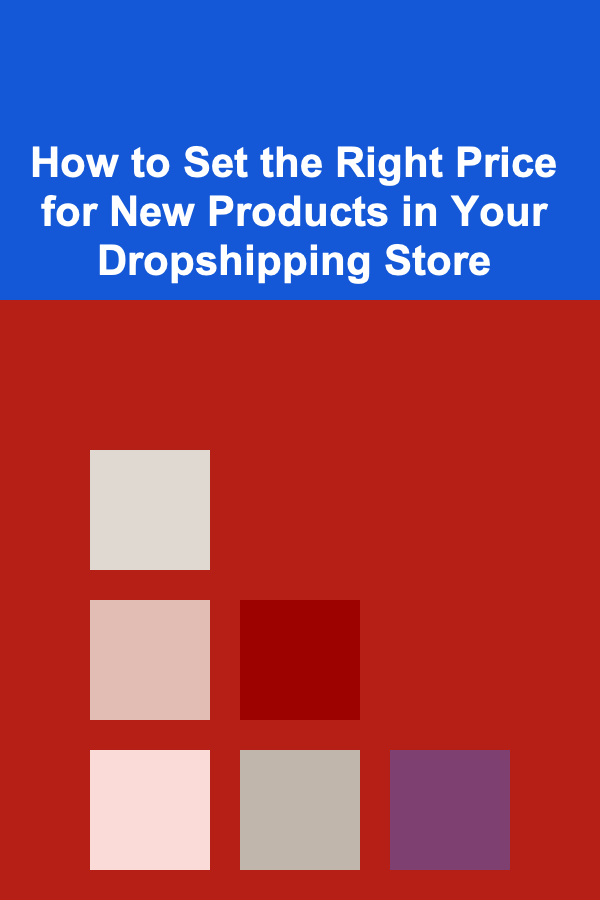
How to Set the Right Price for New Products in Your Dropshipping Store
ebook include PDF & Audio bundle (Micro Guide)
$12.99$11.99
Limited Time Offer! Order within the next:

Pricing your products correctly is one of the most crucial aspects of running a successful dropshipping store. Get it right, and you can maximize your profits while attracting and retaining customers. Get it wrong, and you may find yourself either losing money or failing to generate enough sales.
This actionable guide will walk you through the steps necessary to set the right price for new products in your dropshipping store. By understanding the various factors that influence pricing, you'll be able to make informed decisions that help your business thrive.
Understand the Basics of Pricing
Before diving into the complexities of pricing, it's important to understand the foundational concepts of setting a price. The price of a product is the amount of money you charge customers in exchange for the product. The right price will not only cover your costs and generate profit but will also be perceived as fair and competitive by your target audience.
Key Factors Affecting Price:
- Cost of Goods Sold (COGS): This is the price you pay to your supplier for each product. It's essential to know the cost upfront to ensure you cover it in your pricing strategy.
- Market Demand: The demand for the product will influence what price customers are willing to pay. High demand can justify higher prices, while low demand may require a more competitive price.
- Competitor Pricing: Prices offered by competitors can provide a valuable benchmark for your pricing decisions. Too high, and customers may turn to a competitor; too low, and you may not make enough profit.
- Target Market: Your target audience's buying power and willingness to pay are important. For example, a budget-conscious audience may prefer lower prices, while a premium audience may be willing to pay more for higher quality or exclusivity.
Calculate Your Costs and Profit Margins
The first step in setting a price is to ensure that you cover your costs and generate a reasonable profit margin. Let's break this down:
a. Determine Your Product Cost
The cost of the product is the price you pay to your supplier for each item. In dropshipping, this is usually the most significant cost. However, there may be additional costs like shipping fees, taxes, or import duties that could affect your pricing. Make sure you calculate these as well to avoid underpricing.
For example:
- Product Cost: $10
- Shipping Fee: $5
- Total Product Cost: $15
b. Add Overhead Costs
If you're running an online store, you likely have additional costs that are not directly tied to the product itself, such as website hosting, marketing, transaction fees, and customer service. While these costs can vary widely, they need to be accounted for in your pricing strategy.
For example:
- Monthly Website Hosting: $50
- Marketing Budget: $200 per month
- Transaction Fees: 2.9% + $0.30 per order
Divide your overhead costs by the number of units you expect to sell in a month to calculate the additional cost per product.
c. Set Your Desired Profit Margin
Once you know your total product cost, you can set your profit margin. The profit margin is the percentage of the selling price that represents your profit after costs. For example, if your product costs $15, and you want to earn a 50% profit margin, the selling price would be:
Selling Price=1−Profit Margin PercentageCost of Goods SoldFor a 50% margin:
Selling Price=1−0.5015=30In this case, you would sell the product for $30 to earn a 50% profit margin.
Research Competitor Pricing
While it's important to understand your costs and desired margins, your pricing needs to be competitive within your niche. If your competitors are offering similar products at a lower price, it might be difficult to justify a higher price unless you provide significant value (e.g., superior customer service, faster shipping, etc.).
a. Analyze Competitor Prices
Look at the prices of similar products from your competitors, both on dropshipping platforms like AliExpress and from established e-commerce sites. Pay attention to the overall price range rather than the exact price, as this will give you an idea of where your price should fall.
- If your product is similar in quality and features to a competitor's, you should aim to price similarly.
- If your product has additional features or higher quality, you may be able to justify charging a higher price.
- Conversely, if your product is a commodity item with little differentiation, you might need to price competitively to attract customers.
b. Consider Psychological Pricing
Psychological pricing techniques, like pricing an item at $19.99 instead of $20, can often help make the price appear more appealing to customers. This "charm pricing" can increase conversions because customers perceive prices ending in .99 as being lower than a round number like $20.
Factor in Your Target Market
Knowing your target audience is essential when setting your prices. Different demographics have different spending habits and sensitivities to price changes. Consider the following factors:
- Income Level: If you're targeting budget-conscious consumers, you may need to set a lower price point to appeal to them. On the other hand, if you're selling premium or luxury products, your audience may be willing to pay higher prices for exclusivity and quality.
- Location: Geographic location can impact the price you set. Consumers in high-cost-of-living areas may be accustomed to paying more, while those in lower-cost regions may be more price-sensitive.
- Perceived Value: The perceived value of your product is critical. If your product is seen as high-end or unique, you can charge a higher price. Similarly, adding value through free shipping, exclusive deals, or excellent customer support can justify a higher price.
Test Your Pricing Strategy
Pricing is not set in stone. In fact, one of the best practices is to test different price points to see which performs best. This is called price testing or A/B testing, and it's a common strategy used by successful businesses to determine the most effective price for their products.
How to Test Prices:
- Change the price for a set period and measure how it affects sales volume, conversion rates, and profits.
- Create different price points for different customer segments. For instance, you could offer a discount to first-time buyers or charge more for premium services.
- Track the results closely to see which price point yields the best combination of sales and profitability.
Remember, the objective is to find a balance between competitive pricing and profitability.
Account for Marketing and Advertising Costs
Don't forget to factor in marketing and advertising costs when setting your price. If you're running Facebook or Google ads to promote your products, the cost per acquisition (CPA) must be taken into account. You need to ensure that even with the cost of ads, you're still making a profit.
For example, if it costs you $10 per sale to advertise, that's an additional cost that should be factored into your price. If your product cost is $15, your marketing cost is $10, and your desired profit margin is 30%, your price might need to be set at:
Selling Price=1−Profit Margin PercentageCost of Goods Sold+Marketing CostFor a 30% margin:
Selling Price=1−0.3015+10=35.71In this case, you'd need to charge at least $35.71 to cover your costs and achieve your profit margin.
Monitor and Adjust Regularly
The dropshipping market is highly competitive, and consumer preferences can change quickly. As such, you need to regularly review and adjust your pricing strategy. Monitor factors like:
- Seasonality: Certain products may have higher demand during specific seasons, allowing you to raise prices.
- Sales Performance: If a product isn't selling, you might need to lower the price or add promotions.
- Competitor Changes: Keep an eye on your competitors' pricing and adjust accordingly.
Automated Pricing Tools
There are also automated pricing tools and software available that can help you optimize your prices based on market trends and competitor prices. These tools can adjust your prices in real-time, ensuring you're always competitive while maximizing your margins.
Conclusion
Setting the right price for new products in your dropshipping store is a delicate balance. By factoring in costs, competitor pricing, market demand, and your target audience's willingness to pay, you can set a price that drives sales and ensures profitability.
Regularly review and adjust your prices based on performance and market conditions. And don't forget to use price testing to determine what works best for your specific niche and audience. By carefully considering these factors and continuously optimizing your strategy, you'll be well on your way to building a successful dropshipping business.
Reading More From Our Other Websites
- [Personal Care Tips 101] How to Choose a Dry Shampoo for Traveling
- [Personal Finance Management 101] How to Leverage Employer Benefits for Financial Growth
- [Home Budget Decorating 101] How to Style a Gallery Wall Without Breaking the Bank
- [Digital Decluttering Tip 101] The Ultimate Guide to Decluttering Your Hard Drive and Reclaiming Space
- [Home Renovating 101] How to Plan a Safe and Effective Home Gym Renovation for Small Spaces
- [Organization Tip 101] Why Using Hooks Can Maximize Wall Space
- [Digital Decluttering Tip 101] Best Techniques for Reducing Notification Overload on iOS for Students
- [Home Staging 101] How to Use Strategic Lighting for Home Staging to Make Small Rooms Feel Bigger
- [Personal Financial Planning 101] How to Build Wealth with Real Estate Investments
- [Home Budget Decorating 101] How to Make a DIY Backsplash: Update Your Kitchen in Style

How to Use Lighting to Create a Relaxing Outdoor Space
Read More
How to Implement Blockchain for Supply Chain Transparency
Read More
Origami Modular Design: How to Create Stunning Patterns
Read More
How to Finalize Your College Application Checklist: A Last-Minute Guide
Read More
10 Tips for Recovering After a Basketball Game
Read More
10 Tips for Forensic Scientists in Digital Forensics
Read MoreOther Products

How to Use Lighting to Create a Relaxing Outdoor Space
Read More
How to Implement Blockchain for Supply Chain Transparency
Read More
Origami Modular Design: How to Create Stunning Patterns
Read More
How to Finalize Your College Application Checklist: A Last-Minute Guide
Read More
10 Tips for Recovering After a Basketball Game
Read More